What is an email reactivation campaign? And can it benefit your business?
Your email list is full of customers who've previously bought from you. For some reason they stopped. I’m going to show you how to entice them back. It all starts with a simple email reactivation campaign.
A marketing reactivation campaign is an email campaign that targets three types of prospects:
The purpose of a reactivation campaign is to stimulate a conversation. It’s to get your prospect to put their hand up and say, “Hey, I’m still interested in what you’re selling.”
For the reactivation emails to work, you need to understand why they stopped buying from you in the first place. And you need a strong offer to win them back. Check out the importance of having a message that connects here.
As business owners, it’s tempting to put all our marketing dollars into attracting new customers. But what about those customers who’ve already bought from you?
And here, I’m not talking about those customers who are raving fans—the ones that continue to support your business year after year. I’m talking about the one-time purchases. The customers who, for some reason, haven’t done business with you again.
Do you know why they stopped buying? More importantly, do you know what percentage of these dormant customers make up your email database? The truth is, it costs five times more to acquire a new customer than to sell to an existing one. This means your database of email subscribers is a gold mine.
Email is incredibly powerful. It generates $38 for every $1 spent, making it more effective than social media or any other advertising medium. So the logical solution is to implement email campaigns. But not just any campaign will do.
You need to implement an email reactivation campaign.
But first, I’ll explain why customers stopped buying from you and which ones you want to reactivate. Then I’ll tackle how to implement a reactivation campaign that helps you win back inactive subscribers and make money.
Yes, as much as we all hate to admit it, sometimes we make mistakes, and these mistakes have repercussions. It could be that you delivered poor customer service or your product wasn’t a great fit, whatever. The result was you lost a paying customer.
There’s a large base of customers who are price-shoppers. They’re always on the lookout for the best deal. They’re not loyal, and they’ll never be. It’s a race to the bottom. So if you win a customer on price, you’ll lose them on price.
This is probably the most typical reason for customers leaving. You neglected the relationship. You weren’t nurturing or building it, and sadly, it had turned into a purely transactional relationship.
During this time that they haven’t heard from you, their needs have likely changed. A competitor reaches out, offers a solution that meets their needs today, and there goes your customer.
If you want to retain customers or win back inactive subscribers, you need to make deposits. You can’t just make withdrawals.
I want you to think of your relationships in terms of capital. How can you make more deposits? How can you make the relationship more valuable both ways? When you get this right, you retain customers. And let me tell you, a lifetime customer is invaluable.
So email campaigns are a great way to win back inactive subscribers and get them engaging with your emails. But before I get into the six email reactivation campaign examples, let’s decide which customers you want to come back.
You now know that there are customers within your database who will always buy on price. These are suboptimal customers and aren’t worth investing your time, energy, and money in.
So you need to decide whom you still want and whom you don’t want. There are three criteria I like to use:
It's important to keep these questions in mind when you begin the laborious task of pruning your list of email subscribers.
Now that you know which type of customers you want to target, it's time to turn your attention to your database.
Chances are it’s a mess.
If you’re like most small business owners, your customer data is probably housed in various locations: your email, an excel spreadsheet, a drawer full of business cards, and a CRM.
I like to use Ontraport, but I've also used ConvertKit and ActiveCampaign.
The choice of CRM depends on your list size.
Make sure to remove all duplicates and triplicates (especially if you’re grabbing data from multiple locations).
Reactivation campaigns fail when the message you’re sending isn’t relevant to the receiver. Effectively tagging your database of email subscribers ensures that you can personalize your reactivation emails.
Also, according to Campaign Monitor, business owners using segmented campaigns report a 760 percent increase in revenue. So segmenting is super powerful.
So you want to tag and segment your data by:
You’ve got hundreds, if not thousands, of email addresses that don’t exist.
Perhaps the prospect made a mistake when entering their email address. Maybe they moved companies, and their account was deactivated. Or they got married, changed their name, and created a new email address.
Running a validation test like Never Bounce allows you to pull out those email addresses that no longer exist and delete them.
This allows you to start over with a healthy database.
Once you’ve segmented your database and deleted emails that don’t exist, you’re ready to launch a reactivation campaign.
Remember, the goal of a reactivation email campaign is to get a reply. You want to start a conversation with your inactive subscribers because conversations lead to conversions.
So here are six tried-and-true ways that you can use email to rekindle relationships with inactive subscribers and move them one step closer to making a sale.
Invented by Dean Jackson from I Love Marketing, the 10-word reactivation email is an incredibly successful way to revive dead leads. And it’s so simple.
Here’s an example:
Subject line: John…
Are you still looking for a 50-ft yacht?
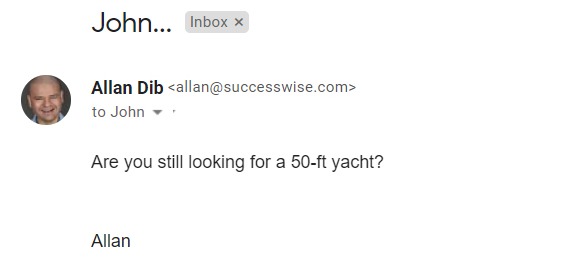
Or whatever you’re selling. This format is golden for any business, and it guarantees great open rates.
Just don’t be tempted to include more information in your engagement email. So forget the deals you’re running, upcoming workshops, whatever. I’d also suggest you hold off on adding graphics or images.
Why it works
It's short and sweet and ends with a question. The brain, for some reason, can't ignore a question. Also, sending a plain text email feels more personal, and people love personalization. So give this reactivation email a chance.
Shoot a personalized video using Loom or Bon Jovi. Then add a thumbnail of the embedded video in your email. And don’t forget to personalize your email subject line.
According to Yes Lifecycle Marketing, emails with personalized subject lines generated a 50 percent higher open rate than those without.
Here's an example video script:
I was going through my contacts recently, and I noticed your name. And I remember we were having a conversation last year about buying (XYZ).
Is this something you're still open to or something that you're looking at right now?
I'd love to re-engage in a conversation with you over email.
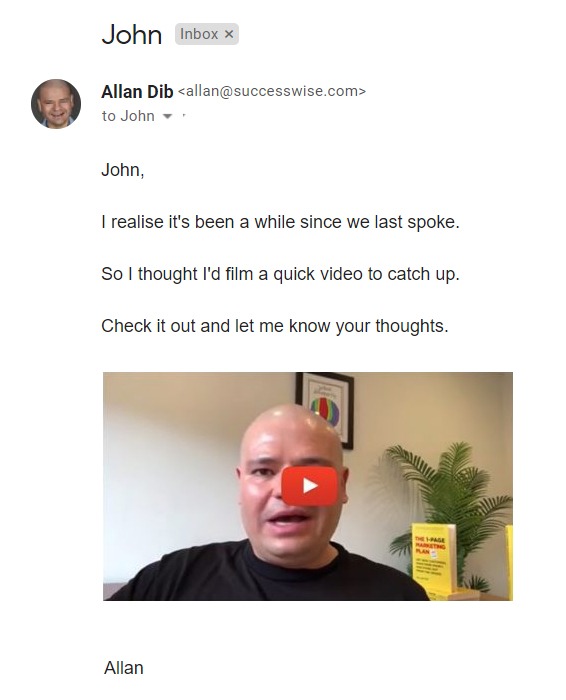
This kind of reactivation email is also great for cold prospecting.
A web designer could share on Loom and create a short video highlighting some of the major concerns on a prospect’s website.
Here’s an example of a script for cold prospecting:
Hey (Name),
I came across your website, and I can see you're doing some really awesome things.
You've got a great call-to-action here, and you've got email opt-ins, but I noticed the design isn't optimal for mobile use.
You know most people now visit websites on their phones, so I'd suggest a few things:
By the way, we're running a webinar next week on website usability. I'd love to invite you to join. It's completely free. There's a link in this email to our webinar. Look forward to seeing you.
Why it works
Sending a video is personal but it’s also engaging. People are more likely to watch a video than read text.
In fact, Martech Advisor’s 2017 data noted that embedding a video in your engagement email can result in a 300 percent click rate. So it’s definitely a strategy worth investigating and implementing.
This is probably the most recognizable reactivation email campaign. We’ve all seen those emails in our inbox with the subject line “We Miss You” or “Thank You.”
Here’s an example of an email script:
Hey (Name),
First I'd like to thank you for being one of our clients. It's people like you who make our business what it is today.
And, second, sorry. You see, I noticed since your last purchase we haven't done enough to get you back here. Perhaps we neglected the relationship or did something wrong, and we'd love to win you back.
So here’s a promo code or offer to put towards your next purchase.
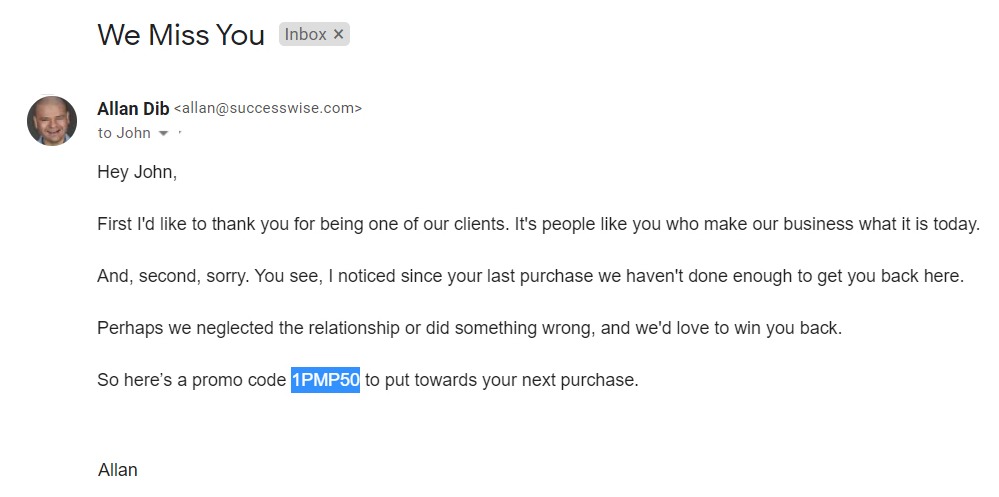
Why it works
You can run campaigns like this online or by regular snail mail. And it works because you’re acknowledging that you haven’t done enough to keep your customer happy in the first place.
You might not have done anything wrong. It could just be apathy on the part of the customer. But by appealing to their ego, they’re more willing to give you a second chance.

Some people might say, why bother? Why not email them a coupon or gift card instead of mailing it? But it’s not the same.
Why it works
There’s an element of surprise and delight. It’s unexpected, and it can also be deployed immediately.
More importantly, people are less inclined to throw away a plastic or metal card with a monetary value. It feels like currency, almost like you’re throwing away dollars.
Also, most people tend to spend more than the value of the gift card.
Just remember to include conditions for redeeming it.
Check out this post for more cool ways to wow customers.
Or discover the power of a shock and awe package. It's perfect for high-value customers.
Another great idea to reengage inactive subscribers is to send them a sample of what you're doing. It needs to be something the prospect can test or consume.
A car salesperson might send an accessory like a branded keychain. A software company could offer a free trial.
You would then follow up on this gift with an engagement email. For example:
Subject line: We hoped you liked our gift.
We noticed you tried (XYZ) software in the past.Would you like to give it a whirl for another 30-day trial?
We've also got someone who can help onboard you and demo how you can use the software. They'll even help you to import all your data.
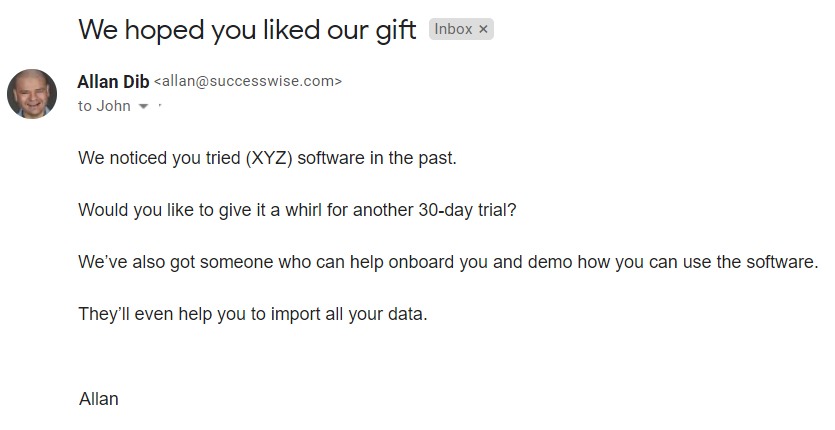
Why it works
It’s exciting. There’s an element of shock and awe, which creates theater around the product. This can be very impressive. Combined with a follow-up email marketing campaign, it's likely to engage inactive subscribers.
And if the prospect doesn’t want to use it, they can give it away to someone else—so you can’t lose.
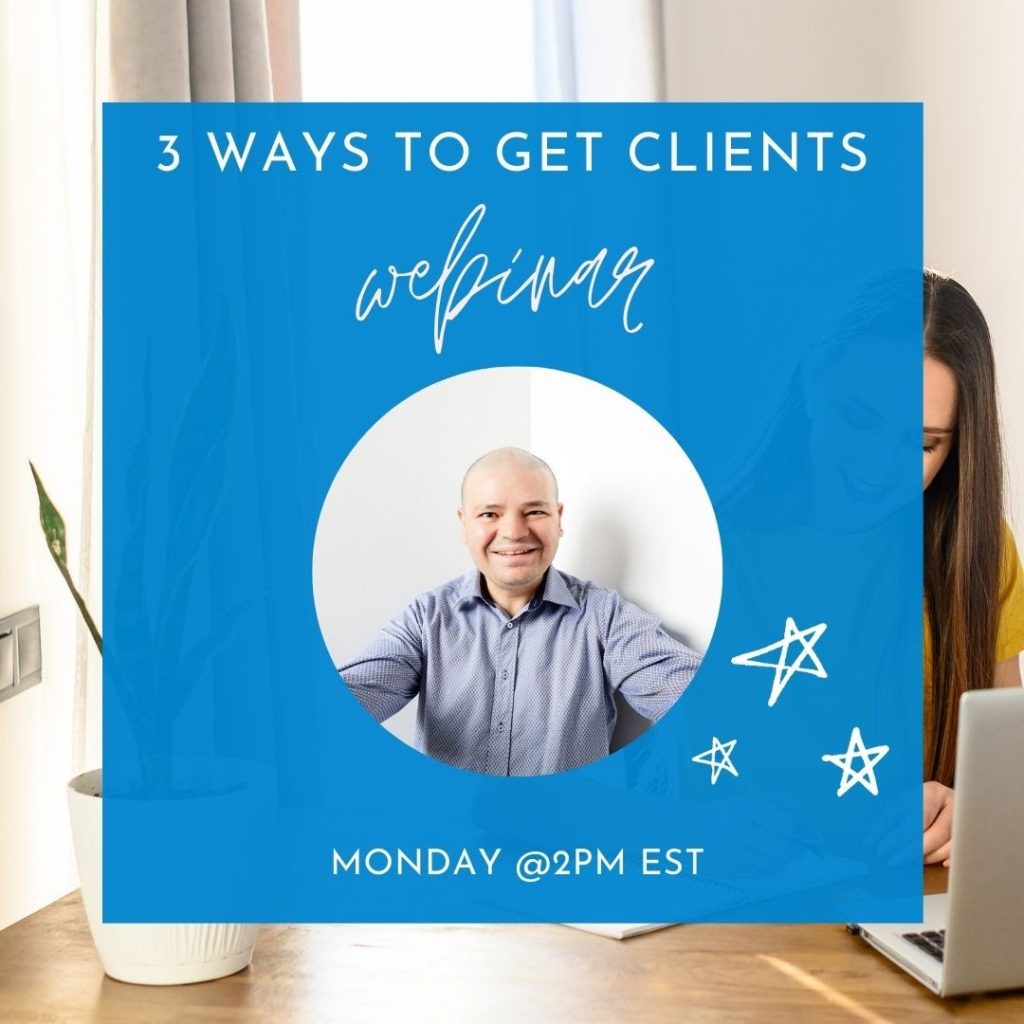
Lastly, you can re-engage inactive subscribers by inviting them to a live event or a virtual summit.
For example, take a client in the e-commerce industry who sells golfing equipment. You could host a live golf event and arrange for a professional instructor or golfer to do a live demonstration.
The golfer could show how to hold a club, correct swing, etc. And those who can’t be there in person can join remotely.
Why it works
These kinds of events allow you to attract a global audience. It gives your prospects a chance to mix with current clients—usually your biggest advocates.
Not only can your inactive subscribers re-engage with you and get excited about your product, but you can also find out why your former clients left and, hopefully, entice them back.
So those are six email examples that you can use to help you get started.
Reactivation email marketing campaigns are super powerful. They allow you to re-engage inactive subscribers and grow your business. While you won't convert every subscriber to a paying customer, you will win back enough to make a difference.
Not only can you make quick money using reactivation emails, but you'll now have a slimmed-down database of high-quality prospects and customers that you can market to more regularly.
And make no mistake, you should send out a reactivation campaign regularly. I’d recommend every quarter.
With the six examples I’ve shared, you can change up each engagement email campaign. Monitor the results. Determine which delivers the best return.
Which example gets the highest open rate? Is it the personalized video option or the 10-word email?
Once you know what works, it’s just a matter of a few tweaks before launching your next email marketing campaign. So get started.
Here's to growing your business.
We want to hear from you. Share your best practices when it comes to crafting engagement emails. What subject lines work best? What reactivation email gets the highest click-through rate? Which email campaigns do you swear by? What's your experience of launching a reactivation campaign?
You'll get new articles delivered straight to your inbox, plus special subscriber-only content such as podcasts, videos and live training events.

Get free weekly emails that make you smarter at marketing and help you grow your business